
10 minute read
The Danish Poster Museum Collection
The Danish Poster Museum Home to a world of posters Focus on Collection
by Elsebeth A. Schanz
Advertisement
Museum Head and Curator The Danish Poster Museum Aarhus, Denmark
All photos courtesy of The Danish Poster Museum
“Use your eyes and the Pedestrian Crossing,” says an admonishing Danish poster from 1941, issued by the Ministry of Justice Committee for greater Safety in Traffic.
The words are backed up by a somewhat surreal picture of a man and a woman whose faces are dominated by a single eye like a Cyclops. There is no doubt that they are doing as they are told. Even the fur collar around the woman’s neck is looking out as she cautiously steps out on the road in heart-shaped shoes. This highly imaginative and humorous poster was designed by one of Denmark’s most outstanding poster artists, Arne Ungerman (1902-1981). It was commissioned during World War II, when the streets were dark because of the obligatory blackout.
Another notable Danish poster artist is Aage Rasmussen (1913-1975), who was extremely productive and especially active with tourist posters. In 1946, he had a poster for Denmark printed with a luxuriant cornfield forming an embracing — or threatening? — wave, rising high above the blue sea, a little cow and a typical Danish village church nestled below. Aage Rasmussen’s great idol was the brilliant French/Ukrainian poster artist, Adolphe Mouron Cassandre (1901-1968). That is clearly obvious in this poster, where one graphically dominant element appears to spring out of the poster frame — precisely as in Cassandre’s imagery. It must have been a wonderful moment for Aage Rasmussen when his poster won a competition, and Cassandre himself was on the jury that nominated Rasmussen’s poster as the winner.
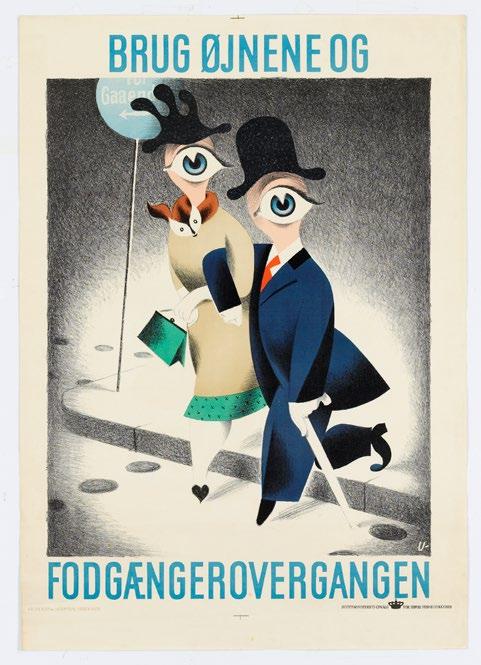
Campaign poster from Denmark: ”Use your eyes and the Pedestrian Crossing” from 1941 designed by Arne Ungermann. During the Occupation in Denmark, the streets were dark because of the obligatory blackout, and this resulted in a series of posters advising people to be careful in the dark. This is one of them, and it approaches the subject with refined humour in almost surrealistic lines.

Tourist poster “Denmark” from 1946, designed by Aage Rasmussen, who still stands out as one of Denmark’s predominant and talented poster artists. Aage Rasmussen was especially known for his tourist posters, but also made a large number of transport posters for the Danish State Railways. He made his breakthrough in 1937 with an express train poster for DSB.

Tourist poster from Denmark, “Wonderful Copenhagen”, dating from about 1968, designed by Ib Antoni. Although Ib Antoni (1929-1973) died far too young, he succeeded in producing a wealth of posters, all with characteristic humour and a varied and experimental feeling for colour. He was particularly occupied with tourist posters, but also touched on a large number of other areas in his work.

Campaign poster from Denmark: “Stop Gossip and Rumours. Don’t tell others what you have heard...” from 1940, by an unknown artist. During World War II there was sharp focus on “careless talk”, meaning gossip and rumours that could be dangerous for others. This applied in all the countries that were at war, and thus in Denmark during the Occupation too. The poster shows a cosy residential area under Dannebrog flags, which were an important national symbol for the population during the Occupation.
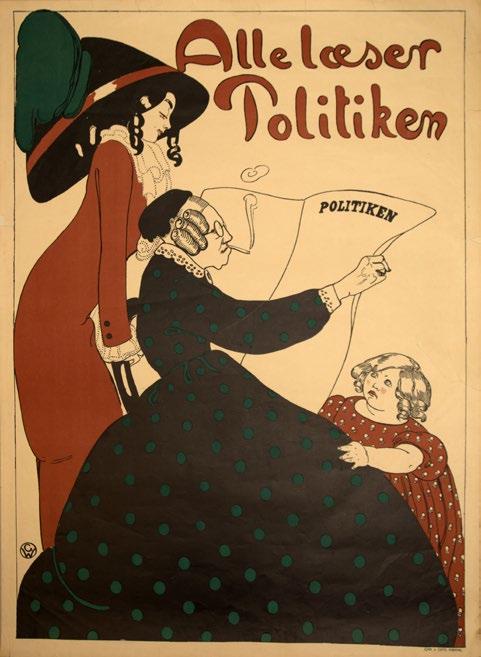
Advertising poster from Denmark: “Everyone reads Politiken” from 1911, designed by Gerda Wegener. The poster shows Gerda Wegener’s (1886-1940) typically decadent and humorous line, influenced by Art Deco, which she had become familiar with when she moved to Paris in 1912. She frequently drew female figures, ranging from the sensual and sometimes directly erotic to depraved decadence. The artist’s model for these women was often Gerda Wegener’s husband, Einar Wegener, who later underwent a sex-change operation to become Lili Elbe.
Both the examples described here are chosen from the rich collection at the state-recognised Danish Poster Museum, a section of the open-air museum Den Gamle By situated in Aarhus. The museum holds a collection of about 200,000 posters, including works from Denmark and the rest of the world. There are countless topics, extending from political and propaganda posters, informative posters, tourist posters, advertising and product posters, film and theatre posters — in short, the entire spectrum of possible subjects. From Hungary, for example, there is an information poster from 1953 campaigning against alcohol abuse. The motif originated from 1912, when a competition was held for posters on the subject; but this motif was so effective that it was still in use more than 40 years later.
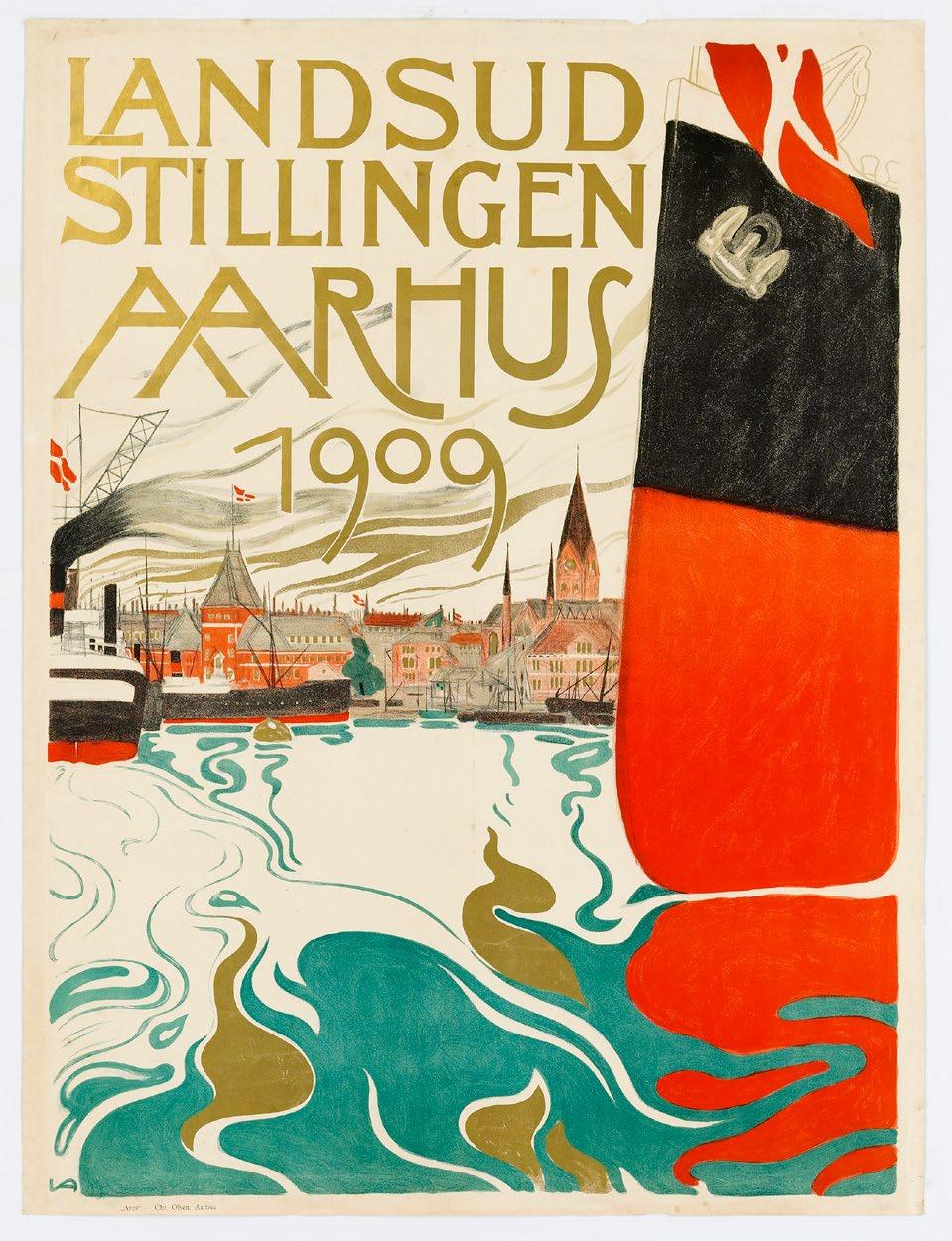
Exhibition poster from Denmark: “National Exhibition Aarhus 1909”, designed by Valdemar Andersen. In 1909, Aarhus was host for the National Exhibition, for which a large number of posters were produced. The competition for the official exhibition poster was won by Valdemar Andersen (1875-1928). He was nicknamed “father of the modern poster”, because he was one of the leaders in introducing modern posters to Denmark.

Exhibition poster from Denmark: “Exhibition for rational housekeeping – Woman and Home – Copenhagen Forum 1-17.Sept.” from 1950, designed by Marlie Brande. There are only a few women among the classic Danish poster artists. Marlie Brande (1911-1979) is one of them, and she was best known for her posters dealing with caring, health, hygiene and sport. On this poster she takes an ironic look at the housewife’s overwhelming burden of work.

Film poster from Denmark: “Fy and Bi larking about”, stamped 1957-58 by the film censor, designed by Sven Brasch. The “Lighthouse and the Trailer” (Fyrtårnet og Bivognen), shortened to Fy and Bi, were a pair of comedians who reached the height of their activities in the 1920s. Known as Long and Short in English, they played on the same slapstick elements as Laurel and Hardy. Well into the 1950s, after both actors were dead, their silent films were still shown in dubbed and often shortened versions.
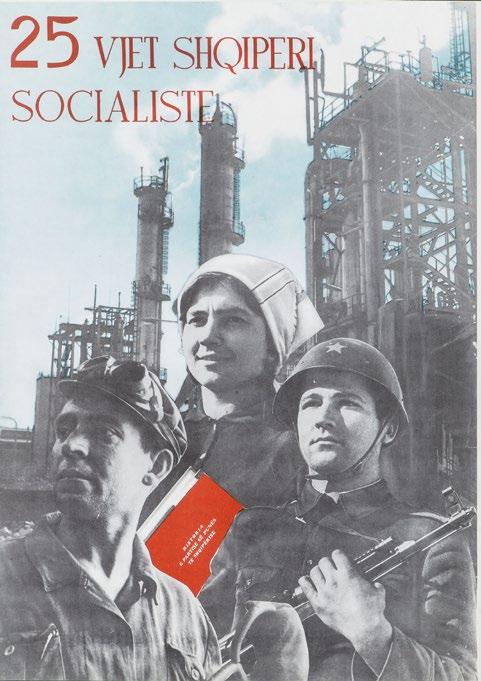
Propaganda poster from Albania, probably from 1971, by an unknown artist. The poster appears to have been printed to celebrate the jubilee of the liberation of Albania from occupation during World War II, and the establishment of the Communist regime. The idiom is typically Soviet, showing the worker and the soldier as heroes defending their country and its ideology. The smoky industry in the background symbolises progress, improvement and success.

Transport poster from Norway, 1935, designed by Paul Lorck Eidem. The poster was issued by the Norwegian State Railways, which explains the railway tracks prominently in the foreground, where they disappear into the mountainside. The most dominant impression, however, is of the magnificent Norwegian landscape.

Campaign poster from Hungary, 1953, by an unknown artist. The original poster dates back to 1912, when it attempted to take up the battle against alcoholism and its tragic consequences. The poster was the result of a competition on the subject, and the motif is so strong and effective that it was re-used in a new campaign in 1953.
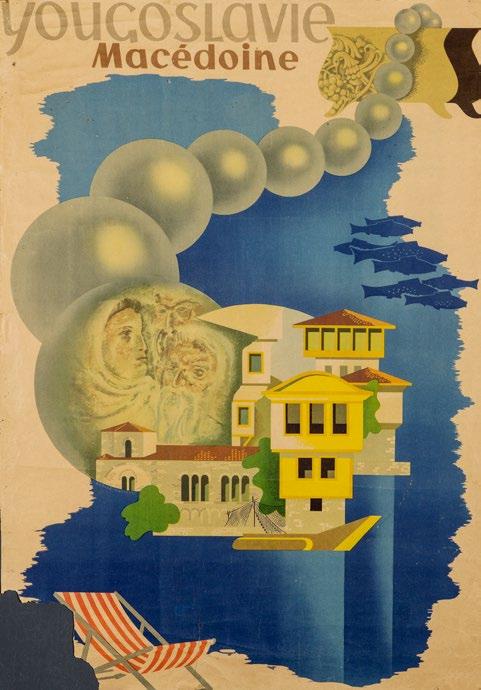
Tourist poster from the region of Macedonia in Yugoslavia in 1955, by an unknown artist. The heritage from antiquity, the architecture, fishing, and a relaxed holiday in the sun by the deep blue sea are all shown in a harmonious artistic interpretation and fine graphic composition.
All the posters in the Poster Museum collection are registered as museum items in an electronic system and stored on a shelving system in large cases. The oldest poster in the collection is purely typographic and dates from the beginning of the 19th century, while the collection’s oldest modern poster with a picture medium dates from the 1890s. Contemporary posters are also collected, and thus the most recent acquisition in the collection is from 2019.
In 2009, the Poster Museum moved into a completely new exhibition building in Den Gamle By, conceived and purpose-built for the posters. The building has two storeys with a total exhibition area of 360 m2, and was designed by the C.F. Møller firm of architects. Here the Danish Poster Museum shows a selection of more than a hundred classic Danish posters, which we have named “The Joy of Recognition” because many of the posters bring back pleasant memories for our visitors. This is a
permanent exhibition, while on the ground floor there are new special exhibitions twice a year. Just now you can see “The Fall of the Wall: German posters before and after 89.” Next year we will be illustrating how the national border was drawn through Schleswig, with Danish and German plebiscite posters from 1920, and posters about other borders that were delineated in Europe after World War I from Poland, Austria, Hungary, and Yugoslavia. In the autumn of 2020, the museum will show propaganda posters from World War II — both the Allies’ posters and those of the Axis Powers.
Thus, the Danish Poster Museum is a museum under constant change, and it is brim-full of posters with a story to tell, simply waiting to be folded out and explained. Even though posters have come in from the streets to the respectable museum area, they still reach out to a wide audience, and still retain their special characteristics from the street forum.
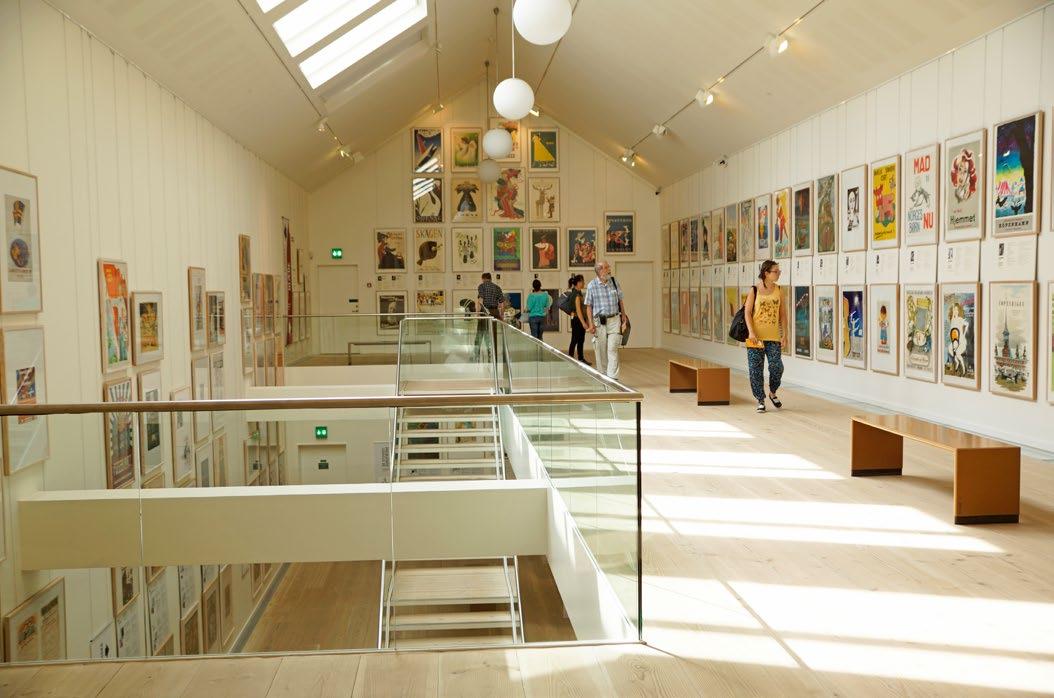
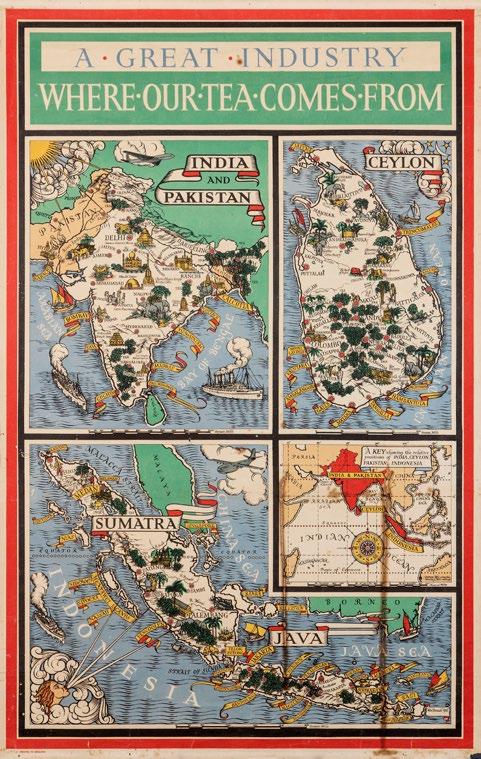
Advertising poster from Great Britain: “Where our tea comes from”, 1920s, designed by Leslie MacDonald Gill. The poster dates from a time when the British Empire was larger than any other European empire ever formed, and it leaves no doubt that at that time Great Britain was a major power. MacDonald Gill (1884-1947) was a talented cartographer and artist.
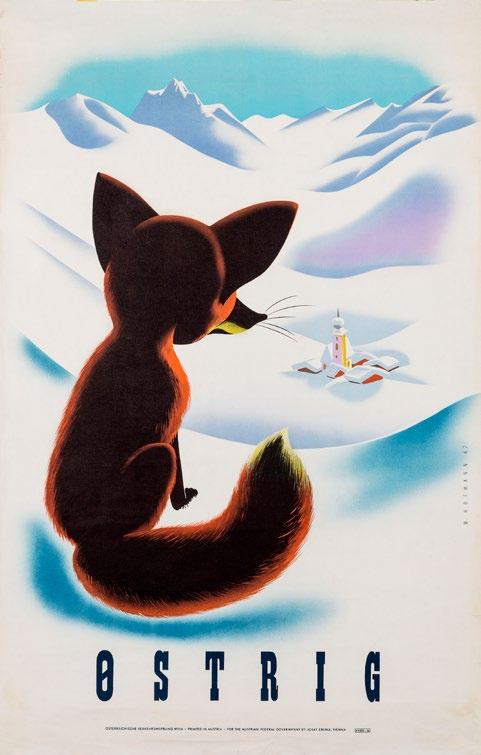
Tourist poster from Austria, 1947, designed by W. Hofmann. The poster is addressed to a Danish audience, and was made just after World War II, when Austria was divided into four zones under Great Britain, France, the USA and the Soviet Union. There is no sign of division in the poster, however; on the contrary, it focuses on peace, stillness and harmony, and an extremely cute fox dominates the motif.

Propaganda poster from East Germany: “The Future belongs to Socialism – working farmers become members of the LPG”, 1958, by an unknown artist. The GDR issued multitudes of idealised propaganda posters showing happy and energetic mothers, children, industrial workers and farmers. This poster glorifies socialism and collectivisation of agriculture.

Political poster from Portugal: “No to Fascism – the fight continues” from 1974, by an unknown artist. On 25 April 1974 there was a coup in Portugal – known as the Carnation Revolution – which overthrew the dictatorship. This poster with its dramatic and aggressive expression dates from this event, and was produced at the request of the United Trade Unions of Lisbon.

The Danish Poster Museum’s collection includes posters from countries all over the world, and also posters of recent date, where the artistic style is primarily significant in the work. Among other things, the museum has a large collection of Japanese posters. “Ueno Zoo”, designed by Kazumasa Nagai in 1993.



